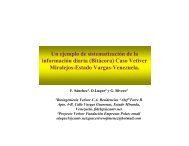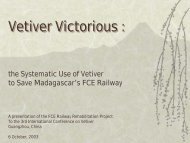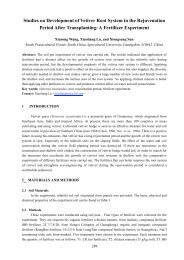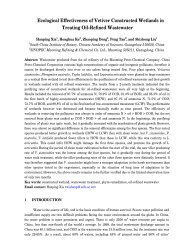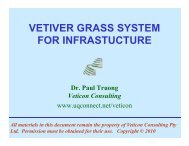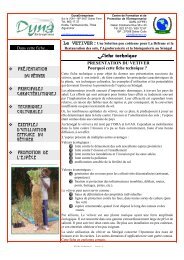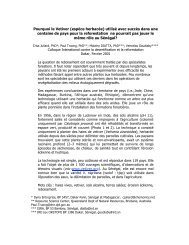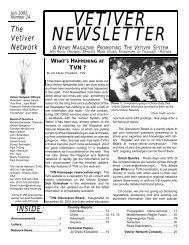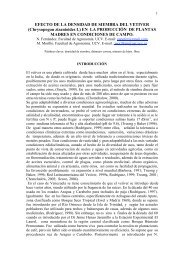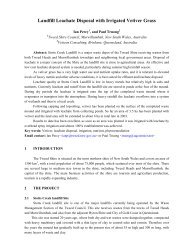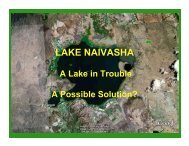Create successful ePaper yourself
Turn your PDF publications into a flip-book with our unique Google optimized e-Paper software.
APPLICATION OF VETIVER GRASS IN<br />
SOIL BASED REED BEDS<br />
FOR EFFLUENT TREATMENT AT<br />
GELITA APA, AUSTRALIA<br />
Cameron Smeal<br />
GELITA Australia, Beaudesert, Queensland, Australia<br />
Paul Truong<br />
Veticon Consulting, Brisbane, Queensland, Australia<br />
Johannes Biala<br />
The Organic Force, Brisbane, Australia<br />
Amanda Butler<br />
Griffith University, Brisbane, Australia
Australia<br />
Beaudesert
Introduction<br />
• The GELITA factory extracts gelatine from cattle hide using<br />
chemical processes involving strong acids, lime and hydroxides.<br />
• This factory is situated on a property of 170 hectares, at<br />
Beaudesert in Queensland, Australia, generates approximately 1.3<br />
ML a day of wastewater<br />
• The effluent from the processing plant is highly saline (average 6<br />
dS/m), dS/m),<br />
alkaline and high in N (300-600mg/L<br />
( 300-600mg/L) and low in P (2 (<br />
mg/L). mg/L).<br />
• The effluent is disposed off by irrigating over 121 hectares of<br />
Kikuyu and Rhodes grasses pasture.
Raw materials:<br />
Fresh Bovine Skins (mainly face pieces)<br />
Raw Materials<br />
Fresh Bovine Skins (mainly<br />
face pieces)
The problems?<br />
• 13 soil types with varying hydraulic<br />
conductivity<br />
• Some saline sodic duplex soils<br />
• Drought<br />
• Sustainability requirements<br />
• How to treat 1.3 ML/day of high<br />
Nitrogen wastewater to a level<br />
suitable for reuse
Rhodes grass pasture at GELITA
Irrigated pasture: long term issues<br />
• Nitrogen disposal requires plant<br />
uptake to exceed application to be<br />
sustainable<br />
• Suppressed soil pH<br />
• Inadequate Nitrogen uptake in<br />
rhodes or kikuyu pasture<br />
• Eucalypt plantation not suited
Comparative N uptake between vetiver, Rhodes grass and Kikuyu<br />
grass<br />
N uptake (kg/ha)<br />
1600<br />
1400<br />
1200<br />
1000<br />
800<br />
600<br />
400<br />
200<br />
0<br />
443<br />
937<br />
1 442<br />
1442<br />
111<br />
248<br />
12 weeks<br />
6 months<br />
9 months<br />
373<br />
373<br />
190<br />
428<br />
Vetiver Rhodes Kikuyu<br />
642<br />
642
N kg/ha/year<br />
1200<br />
1000<br />
800<br />
600<br />
400<br />
200<br />
0<br />
Vetiver Dryland<br />
1,140<br />
Rhodes Grass<br />
NITROGEN UPTAKE<br />
600<br />
Kikuyu Grass<br />
500<br />
Forage Sorghum<br />
360<br />
Plant Species<br />
Rye grass<br />
250<br />
Eucalyptus<br />
90
Biomass=nitrogen export<br />
• Typical pasture grasses do not<br />
generate enough biomass to reduce<br />
Nitrogen loading to soil<br />
• However, Vetiver annual biomass<br />
production is approximately 132/t/ha
Comparative yield between vetiver, Rhodes grass and Kikuyu grass<br />
DM (t/ha/year)<br />
140<br />
120<br />
100<br />
80<br />
60<br />
40<br />
20<br />
0<br />
40.7<br />
88.3<br />
132.4<br />
132.4<br />
6.1<br />
13.3<br />
19.9<br />
19.9<br />
12 weeks<br />
6 months<br />
9 months<br />
7<br />
15.2<br />
22.7<br />
Vetiver Rhodes Kikuyu
Kikuyu grass pasture
Vetiver grass paddock
Constraints<br />
The Queensland government has applied strict<br />
regulations regarding the disposal of this wastewater.<br />
In order to meet these regulatory requirements and to<br />
fulfil expectations of Ecologically Sustainable<br />
Development, GELITA has undertaken a<br />
comprehensive research program to develop optimal<br />
disposal methodologies.<br />
Due to extreme climatic variations over the eleven years<br />
of operation the planting of typical pasture and annual<br />
crops has not provided a viable outcome.
Eucalyptus plantation<br />
Kikuyu pasture
Atrazine Trial<br />
Centre pivot<br />
Aerial view<br />
<strong>Reed</strong>bed/transpiratio<br />
n<br />
Tr<br />
ap<br />
D<br />
a<br />
m<br />
---<br />
-<br />
----Trap Dam<br />
If this document is not on blue paper it is an uncontrolled copy and the information it contains may be out of date.
Options and Solutions<br />
•Alternative solutions such as chemical treatment and<br />
transportation to sewage treatment plant were considered<br />
but both of these are impractical and most importantly,<br />
very costly to build and to operate.<br />
• Tree planting was one of the earlier options considered,<br />
it has been trialed for several years but has not provided<br />
an effective solution to the problems faced by the company.<br />
• Application of the Vetiver System for wastewater<br />
treatment is a new and innovative phytoremedial<br />
technology and VS was identified as having the potential<br />
to meet all the criteria.<br />
• The vetiver option using MEDLI as a model offers a<br />
practicable and cost effective solution.
The MEDLI Computer model<br />
MEDLI is a Windows based computer model for designing and<br />
analysing effluent disposal systems, which use land irrigation,<br />
for a wide range of industries such as piggeries, feedlots,<br />
abattoirs, sewage treatment plants, and food processing<br />
factories.
ADVANCED APPLICATIONS<br />
Although MEDLI has reduced the planting area<br />
from 130ha to 70ha, this model is designed as an<br />
effluent disposal method.<br />
GELITA is interested in more advanced applications<br />
of VS in effluent treatment and the company is<br />
currently conducting research in development of <strong>Soil</strong><br />
<strong>Based</strong> <strong>Reed</strong> <strong>Beds</strong> with the aims of:<br />
• reducing this planting area further and<br />
• recycling of the wastewater
<strong>Soil</strong> <strong>Based</strong> <strong>Reed</strong> <strong>Beds</strong> (SBRB)<br />
The SBRB system has three simple components:<br />
• A shallow bed of soil<br />
• A suitable plant<br />
• Micro-organisms (fungi and bacteria)
RESEARCH OBJECTIVES<br />
GELITA Australia initiated field research in order to:<br />
• Demonstrate the suitability of vetiver grass for use in<br />
the SBRB system to treat nitrogen rich industrial<br />
effluent<br />
• Use the research findings in order to develop and<br />
establish a SBRB system that is capable of purifying<br />
GELITA’s wastewater to a satisfactory level and<br />
• Develop a SBRB system using vetiver grass suitable<br />
for Australia and world wide.
WHY VETIVER GRASS INSTEAD OF PHRAGMITES?<br />
Traditionally Phragmites australis is the preferred species in reed<br />
bed planting.<br />
Phragmites has:<br />
• a relatively shallow root system, typical feature of wetland<br />
plants<br />
• a slow recovery growth after harvesting as it relies on the<br />
growth of new shoots from rhizomes and seeds instead of the old<br />
shoots.<br />
• a major weedy pest in all wetlands and waterways due to its<br />
prolific seeding habit
WHY VETIVER GRASS INSTEAD OF PHRAGMITES<br />
Vetiver:<br />
• Has a prolific and deep root system<br />
• Proven tolerant to high level of pollutants, including heavy<br />
metals and nutrients particularly N and P<br />
• Has high capacity of absorbing these pollutants<br />
• Grows well under extremely adverse conditions such high<br />
salinity, high acidity and alkalinity and sodicity<br />
• Is sterile and producing no seeds therefore no weed potential
VETIVER GRASS IN REED BEDS<br />
Summerfelt et al (1999) used vetiver grass in a study for the<br />
removal and stabilization of aquaculture sludge, has found that<br />
Vetiver removed:<br />
• Total Suspended Solid 96- 98 %<br />
• Total COD 72- 91 %,<br />
• Dissolved COD 30-81%<br />
• Dissolved phosphate, total Kjeldahl nitrogen, and total<br />
phosphorus 82_93%
SBRB DESIGN AT GELITA<br />
Longitudinal Section<br />
Cross Section
Inlets at<br />
top end<br />
of bay<br />
Outlets at low end of bay<br />
3 levels of<br />
outlets
Mean<br />
Hydra<br />
ulic<br />
Cond<br />
uctivit<br />
Infiltration rate<br />
y<br />
(ml/s)<br />
0.2<br />
0.15<br />
0.1<br />
0.05<br />
0<br />
THE SOILS<br />
Three types of soil were used:<br />
1- Gravely soil 2- Sandy loam 3- Black cracking clay<br />
Gravel<br />
Infiltration rates<br />
Sandy loam<br />
Gravel Sandy Loam Black Cracking Clay<br />
Type of Medium<br />
Clay<br />
Figure 5.2: Summary of Infiltration rate for gravel, sandy loam<br />
and black cracking clay
40m<br />
<strong>Reed</strong> bed construction<br />
4m
<strong>Reed</strong> bed construction:<br />
• Lining with thick waterproof<br />
membrane<br />
• Fill in with soil/sand or gravel
Inlet<br />
Inlet and outlets<br />
Outlets<br />
3 levels of<br />
outlets
New planting on sand bed
Preliminary results<br />
<strong>Based</strong> on a six day hydraulic retention time<br />
Root depth approximately 60cm<br />
<strong>Soil</strong>s colloidal adsorption effect not yet at<br />
steady state<br />
pH<br />
EC (micro<br />
siemens) NOx mg/L PO4 mg/L TN mg/L<br />
Tap water 7.71 454 n/a n/a n/a<br />
Clay 6.12 3780 3.8 1.1 28<br />
Gravel 7.43 3240 20.4 0.2 20<br />
Sand 6.87 1265 6.4 0.8 8<br />
Effluent in to<br />
reed bed 7.71 7100 21.7 2.2 452
<strong>Soil</strong> <strong>Based</strong> <strong>Reed</strong> <strong>Beds</strong> set up<br />
Thank YOU



